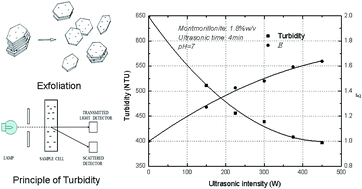Evaluation of exfoliation degree of montmorillonite in aqueous dispersions through turbidity measurement
Abstract
In this work, the exfoliation of montmorillonite (MMT) in aqueous suspensions was investigated through the measurement of turbidity. The experimental results have shown that the turbidity is closely correlated to the exfoliation degree of MMT in aqueous suspensions. Below the solid concentration of 2% w/v and in the range of pH 4–10, the turbidity of aqueous dispersions of MMT without exfoliation appeared constant, while it decreased on increasing the exfoliation degree of MMT. The ratio of the turbidities before and after the exfoliation (τ0/τ) was directly proportional to the number of fresh MMT flakes formed from the exfoliation. τ0/τ was termed the exfoliation degree E. The larger the value of E, the more MMT flakes formed. It has been found that the exfoliation of MMT in aqueous dispersions was depressed due to the presence of electrolytic ions. This depression increased with the increase of ion concentration and valence.



 Please wait while we load your content...
Please wait while we load your content...